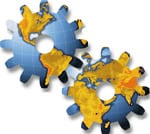Proponents of the theory that emerging markets are decoupling from the West’s economies have had a tough year. Their vision may yet be coming true, though.
 |
If the United States sneezes, the rest of the world catches a cold.” That is the adage that has characterized global markets for the past several decades and is borne out by the fact that past US financial upheaval, including the dot-com collapse, saw economic growth decline in other markets, with some of the biggest falls in Latin America as well as Asian markets.
According to International Monetary Fund (IMF) analysts, the potential size of spillovers from economic downturns in the US has increased with greater trade and financial linkages. As the world’s largest economy, the US is the largest importer of goods and also boasts a sizeable and globally influential financial market. Additionally, those developing markets that have sustained fixed exchange rate regimes and higher levels of external debt denominated in US dollars have also tended to feel the impact of a US recession more.
But in recent years a number of economic fundamentals shifted, leading some to speculate that linkages between what was happening in the US economy and other markets were no longer relevant. Some of the biggest changes occurred in Asian emerging markets. Following the 1997 Asian crisis, they became less reliant on short-term foreign capital for financing domestic growth and cleaned up their balance sheets, reducing their indebtedness.
A number of Asian markets also moved from fixed exchange rate regimes pegged to the US dollar to a floating exchange rate in order to better defend their currencies. Emerging markets also began stockpiling substantial foreign exchange reserves to act as a buffer against any external shocks. The emergence of the BRIC (Brazil, Russia, India and China) phenomenon also created a new generation of consumers and a burgeoning middle class, reducing countries’ dependence on exports to markets such as the US for growth. “Domestic demand is, in time, likely to become an increasingly important driver of growth across Asia, particularly as we see the emergence of a debt-free middle class,” says Gerard Lyons, chief economist and group head of global research for Standard Chartered Bank.
 |
|
Alomar: Chinese manufacturers have been hit by the credit crunch. |
China’s entry onto the global economic stage also means it has become a key export market for many Asian countries, being the number-one export destination for Hong Kong, South Korea and Taiwan, says Lyons. With China becoming an economic powerhouse in its own right and market fundamentals turning in favor of developing markets, the idea that growth in the largest emerging markets—notably China, India and to some extent Latin America—had “decoupled” or was no longer dependent on growth in the US economy started gaining credibility.
And when economists painted a rather gloomy economic picture for the US at the start of 2007 and a much rosier outlook for Asia, it was interpreted as further evidence of decoupling at work. Even when the subprime mortgage crisis first broke in the US, emerging markets were not directly hit as banks in the region had little or no exposure to the complex financial instruments that landed so many Western banks in hot water. But as the subprime crisis led to banking failures in the US, panic started to spread across financial markets.
In October stock markets went into freefall as investors piled out of assets perceived as riskier. Some of the biggest stock market falls were in emerging markets. According to Lyons of Standard Chartered, in the first three quarters of 2008 the main equity indexes were down 63% in Shanghai, 25% in Korea, 36% in Indonesia, 53% in Vietnam and 35% in India. By mid-October the BRIC index was down 57%.
Suddenly the “decoupling” theory looked unconvincing. “The economic climate is clearly changing,” Lyons says. “As global growth slows and inflation pressures ease, the market is now starting to appreciate that Asia is not decoupled from growth in the West.” As the US enters a recession and growth in Europe and Japan remains sluggish, Lyons says emerging economies are not immune.
Not All Will Suffer
Observers draw a clear distinction between “openly traded” economies in Asia, which they believe will be hit harder by the global slowdown, and those with current account surpluses, healthy fiscal positions or driven more by domestic demand, which are better insulated. “Countries with large current account deficits and budget deficits, these countries are not decoupled and will slow as much as developed countries,” says Yvan Mamalet, a senior economist with Société Générale Asset Management in London. “Other countries that have current account surpluses and rising FX reserves and public surpluses are more resilient to external shocks.” China, most Asian surplus economies and a number of Middle East countries fit the latter category, but while they are resilient, they are not totally decoupled, says Mamalet.
 |
|
Mamalet: Countries with large budget deficits are not decoupled. |
With globalization, countries are getting closer to one another, and to think that they can totally decouple from major crises is unreasonable, says Nicholas Kwan, regional head of Asia research for Standard Chartered Bank. Mamalet adds that it is impossible for those Asian economies that are export-led and therefore influenced by global events to totally decouple.
Karl Alomar, CEO of China Export Finance, says in recent months some Chinese exporters have found it difficult to maintain historical levels of growth as wavering international consumer demand has had a direct impact on buyers’ orders. “China has witnessed a significant number of smaller-manufacturer bankruptcies, mainly among the mom-and-pop-style manufacturers,” he says.
But while decoupling does not apply in terms of exports or financial services (interbank lending rates and liquidity have been affected across most markets), Mamalet says that there is some decoupling in terms of domestic demand remaining resilient but that this differed from country to country. “We believe there is enough domestic demand in China to compensate for a slowdown in exports,” he remarks.
However, the rate of economic growth in China and emerging Asia is expected to slow in response to what is happening in the US. “The region is not decoupled,” says Lyons, “but it is better insulated to cope with a global slowdown.”
Events of the past few months may have diluted the decoupling theory, yet one truism remains: Economic power has shifted from developed markets to cash-rich emerging markets. “If anything,” says Kwan, “the current situation presents some opportunities for Asia. Previously, investment flows were from West to East, but now we are likely to see increasing flows from East to West.”
Anita Hawser



